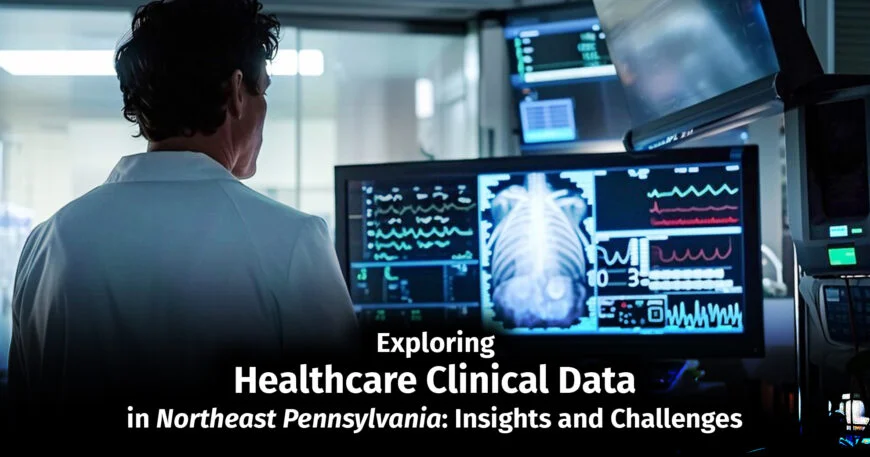Introduction:
In the dynamic world of healthcare, the availability and analysis of clinical data play a critical role in shaping patient outcomes, optimizing healthcare delivery, and informing strategic decision-making. . Northeastern Pennsylvania, with its diverse healthcare landscape, presents a unique case study examining the complexity of clinical data. This blog looks at clinical health data insights in Northeast Pennsylvania, uncovering both the opportunities and
challenges associated with them.
The Health Tapestry of Northeast Pennsylvania
1.1.Healthcare Facilities Overview
Northeast Pennsylvania has a rich selection of healthcare facilities, ranging from large medical centers to community clinics. These facilities serve a diverse population spanning urban and rural areas. To appreciate the nuances of clinical data and its impact on patient care, it is critical to understand the scope and extent of healthcare services in the region.
1.2.Collaboration and Integration
Collaboration between healthcare providers is critical to the seamless exchange of clinical data. In Northeast Pennsylvania, several initiatives aim to integrate electronic health records (EHRs) and create interoperable systems. Collaboration between hospitals, primary care providers and specialty clinics contributes to a more comprehensive view of patient health.
Harnessing the power of clinical data
2.1.Electronic Health Records (EHR)
The introduction of electronic health records has transformed health information management in Northeast Pennsylvania. EHRs facilitate the digitization of patient information, streamline communication between healthcare providers, and improve access to critical data. This centralized approach improves the coordination of patient care and supports evidence-based decision-making.
2.2.Patient Outcomes and Population Health
Clinical data analysis enables healthcare providers to assess patient outcomes and contribute to population health management. Northeast Pennsylvania’s healthcare ecosystem uses data-driven insights to identify health trends, predict disease prevalence and implement preventive measures. This proactive approach not only improves patient outcomes but also reduces long-term healthcare costs.
Insights from clinical data
3.1.Disease surveillance and management
Clinical data serves as a valuable tool for disease surveillance and management. In northeastern Pennsylvania, health experts are using data analytics to monitor the prevalence of chronic diseases, track outbreaks, and develop targeted interventions. This proactive approach helps with early detection, timely intervention, and development of personalized treatment plans.
3.2.Identifying Health Disparities
Clinical data analysis enables healthcare stakeholders to identify and address health disparities within the diverse population of northeastern Pennsylvania. By examining demographic information, socioeconomic factors, and health outcomes, healthcare providers can tailor interventions to specific communities, ensuring equitable access to quality care.
3.3. Quality Improvement Initiatives
Clinical data serves as a compass for quality improvement initiatives in healthcare. Healthcare organizations in Northeast Pennsylvania use data analytics to evaluate the effectiveness of clinical processes, measure adherence to best practices, and identify opportunities for improvement. This continuous improvement cycle improves the overall quality of care for the community.
Challenges in Clinical Data Exploration.
4.1. Data Interoperability and Standardization
Despite concerted efforts, achieving seamless data interoperability in Northeast Pennsylvania remains a challenge. Differing EHR systems, different data formats, and lack of standardized protocols hinder the efficient exchange of clinical information. Addressing these interoperability challenges is critical to a holistic and integrated approach to patient care.
4.2. Data Security and Privacy Concerns
As healthcare organizations digitize patient records, ensuring data security and privacy becomes increasingly important. Northeastern Pennsylvania, like many other regions, faces the need to balance data access for healthcare providers with protecting patient confidentiality. Implementing robust cybersecurity measures and adhering to strict data protection regulations are ongoing challenges.
4.3. Limited Resources and Infrastructure
Some healthcare providers in northeastern Pennsylvania, particularly those in rural areas, face resource and infrastructure limitations. Limited access to advanced technology, data analysis tools, and trained personnel can hinder the comprehensive examination of clinical data. Addressing these disparities is critical to ensuring all communities benefit from data-driven health initiatives.Future prospects and innovations
5.1. Artificial Intelligence in Healthcare
The integration of artificial intelligence (AI) holds promise for advancing clinical data exploration in northeastern Pennsylvania. Artificial intelligence applications such as predictive analytics and machine learning can improve disease prediction, automate data analysis, and support personalized treatment plans. Adopting these innovations can lead the region to more efficient and effective healthcare delivery.
5.2. Telemedicine and remote patient monitoring
The rise of telemedicine and remote patient monitoring opens new dimensions in clinical data exploration. Northeastern Pennsylvania, with its mix of urban and rural areas, can leverage these technologies to close gaps in healthcare access. Integrating telehealth data with traditional clinical data provides a more comprehensive view of the patient’s health and improves care coordination. Community cooperation and participation.
6.1. Collaborating with Stakeholders
Addressing challenges and maximizing the potential of clinical data requires collaborative efforts between healthcare stakeholders, government agencies, technology providers, and the community. Northeast Pennsylvania can establish knowledge-sharing forums, standardization efforts, and collaborative initiatives to advance a unified approach to health data research.
6.2. Empowering Community
Community engagement in health data initiatives is critical to building trust and ensuring interventions are aligned with the needs of Northeastern Pennsylvania’s diverse population. Initiatives such as community health assessments, health education programs, and feedback mechanisms enable residents to actively participate in their health care.
Conclusion: A Roadmap to Data-Driven Healthcare
In summary, examining clinical healthcare data in Northeast Pennsylvania reveals a landscape filled with opportunities and challenges. Harnessing the power of clinical data can revolutionize patient care, support public health strategies, and drive healthcare innovation. As the region grapples with the complexities of data interoperability, security and resource limitations, collaborative efforts, technological advances and community engagement will be key to unlocking the full
potential of clinical data and ensuring a healthier future for Northeast Pennsylvania.











